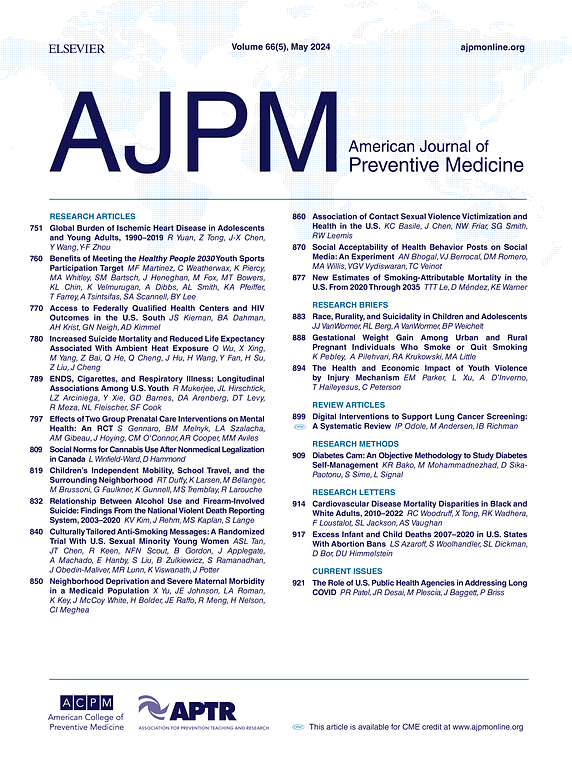Cost-Effectiveness of Mandating Calorie Labels on Prepared Foods in Supermarkets
IF 4.3
2区 医学
Q1 MEDICINE, GENERAL & INTERNAL
引用次数: 0
Abstract
Introduction
The U.S. has required chain food establishments—including supermarkets—to display calorie labels on prepared (i.e., ready-to-eat) foods since 2018. Implementation of this supermarket calorie labeling policy reduced purchases of prepared foods from supermarkets, but it remains unknown whether the policy is cost-effective.
Methods
In 2023–2024, this study applied the Childhood Obesity Intervention Cost-Effectiveness Study (CHOICES) microsimulation model to estimate the effects of the supermarket calorie labeling policy on health, costs, and cost-effectiveness over 10 years (2018–2027) for the U.S. population. The model projected benefits overall and among racial, ethnic, and income subgroups. Sensitivity analyses varied assumptions about the extent to which consumers replace calorie reductions from prepared foods with calories from other sources (i.e., caloric compensation).
Results
From 2018–2027, the supermarket calorie labeling policy was projected to save $348 million in healthcare costs (95% Uncertainty Interval [UI]=$263, $426 million), prevent 21,700 cases of obesity (95% UI: 18,200–25,400), including 3,890 cases of childhood obesity (95% UI=2,680, 5,120), and lead to 15,100 quality-adjusted life years (QALYs) gained across the U.S. population (95% UI=10,900, 20,500). The policy was projected to prevent cases of obesity and childhood obesity across all racial, ethnic, and income groups. The policy was projected to be cost-saving when assuming low and moderate caloric compensation and cost-effective when assuming very high caloric compensation.
Conclusions
A policy requiring calorie labels on prepared foods in supermarkets was projected to be cost-saving or cost-effective and lead to reductions in obesity across all racial, ethnic, and income groups.
强制超市预制食品标注卡路里的成本效益。
导言:美国自 2018 年起要求连锁食品企业(包括超市)在预制食品(即即食食品)上显示卡路里标签。这项超市热量标签政策的实施减少了人们从超市购买熟食的次数,但该政策是否具有成本效益仍是未知数:2023-2024 年,本研究应用儿童肥胖干预成本效益研究(CHOICES)微观模拟模型,估算了超市热量标签政策在 10 年内(2018-2027 年)对美国人口的健康、成本和成本效益的影响。该模型预测了整体利益以及种族、民族和收入亚群的利益。敏感性分析改变了关于消费者用其他来源的热量替代预制食品热量减少的程度(即热量补偿)的假设:从 2018 年到 2027 年,超市热量标签政策预计将节省 3.48 亿美元的医疗成本(95% 不确定区间 [UI]:2.63-4.26 亿美元),预防 21,700 例肥胖症(95% UI:18,200-25,400 例),其中包括 3,890 例儿童肥胖症(95% UI:2,680-5,120 例),并使全美人口获得 15,100 个质量调整生命年(QALYs)(95% UI:10,900-20,500)。预计该政策可预防所有种族、民族和收入群体的肥胖症和儿童肥胖症。在假设低热量和中等热量补偿的情况下,预计该政策可节约成本,而在假设高热量补偿的情况下,则具有成本效益:结论:预计一项要求超市预制食品标注热量的政策可节约成本或具有成本效益,并可减少所有种族、民族和收入群体的肥胖症。
本文章由计算机程序翻译,如有差异,请以英文原文为准。
求助全文
约1分钟内获得全文
求助全文
来源期刊

American Journal of Preventive Medicine
医学-公共卫生、环境卫生与职业卫生
CiteScore
8.60
自引率
1.80%
发文量
395
审稿时长
32 days
期刊介绍:
The American Journal of Preventive Medicine is the official journal of the American College of Preventive Medicine and the Association for Prevention Teaching and Research. It publishes articles in the areas of prevention research, teaching, practice and policy. Original research is published on interventions aimed at the prevention of chronic and acute disease and the promotion of individual and community health.
Of particular emphasis are papers that address the primary and secondary prevention of important clinical, behavioral and public health issues such as injury and violence, infectious disease, women''s health, smoking, sedentary behaviors and physical activity, nutrition, diabetes, obesity, and substance use disorders. Papers also address educational initiatives aimed at improving the ability of health professionals to provide effective clinical prevention and public health services. Papers on health services research pertinent to prevention and public health are also published. The journal also publishes official policy statements from the two co-sponsoring organizations, review articles, media reviews, and editorials. Finally, the journal periodically publishes supplements and special theme issues devoted to areas of current interest to the prevention community.
 求助内容:
求助内容: 应助结果提醒方式:
应助结果提醒方式:


